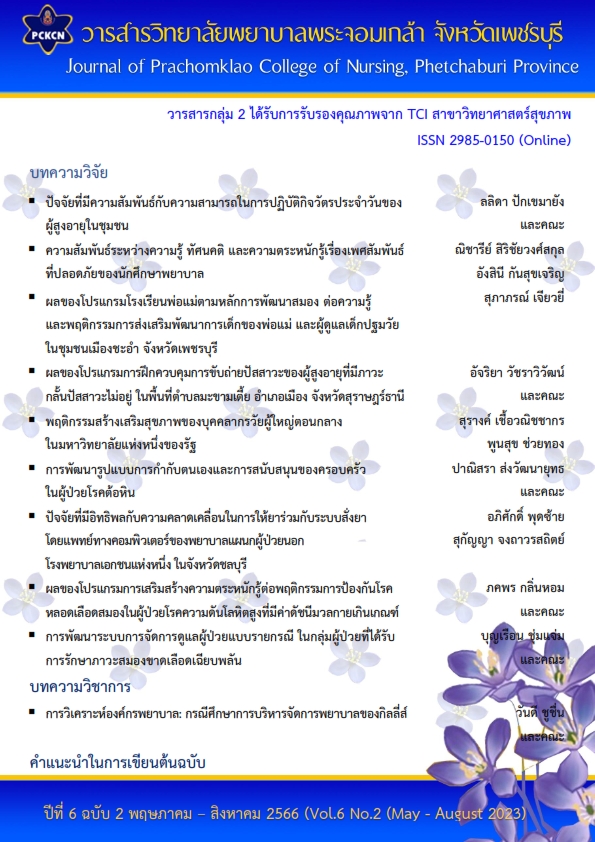การพัฒนาระบบการจัดการดูแลผู้ป่วยแบบรายกรณี ในกลุ่มผู้ป่วยที่ได้รับการรักษาภาวะสมองขาดเลือดเฉียบพลัน
Main Article Content
บทคัดย่อ
วิจัยและพัฒนา มีวัตถุประสงค์เพื่อ 1) พัฒนาระบบจัดการดูแลผู้ป่วยแบบรายกรณี ในกลุ่มผู้ป่วยที่ได้รับการรักษาภาวะสมองขาดเลือดเฉียบพลัน และ 2) ศึกษาผลลัพธ์ของระบบจัดการดูแลผู้ป่วยแบบรายกรณี ในกลุ่มผู้ป่วยที่ได้รับการรักษาภาวะสมองขาดเลือดเฉียบพลัน โรงพยาบาลนพรัตนราชธานี ดำเนินการวิจัยระหว่างวันที่ 17 สิงหาคม 2565 – 9 พฤษภาคม 2566 แบ่งออกเป็น 4 ขั้นตอน ได้แก่ 1) ระยะวางแผน 2) ระยะลงมือปฏิบัติ 3) ระยะสังเกต และ 4) ระยะสะท้อนกลับ กลุ่มตัวอย่างเป็นพยาบาลวิชาชีพ จำนวน 11 คน คัดเลือกแบบเจาะจง และผู้ป่วยที่ได้รับการรักษาภาวะสมองขาดเลือดเฉียบพลัน จำนวน 60 คน เก็บรวมรวมข้อมูลโดยใช้แบบข้อมูลส่วนบุคคล แบบประเมินระดับความรุนแรงทางระบบประสาท แบบติดตามประเมินผลลัพธ์การจัดการรายกรณี แบบประเมินความพึงพอใจของพยาบาล และแบบทดสอบความรู้ของพยาบาล ซึ่งมีค่าความเชื่อมั่นสัมประสิทธิ์แอลฟาของครอนบาค .85, .93 และ .94 ตามลำดับ วิเคราะห์ข้อมูลโดยใช้สถิติพรรณนา การทดสอบวิลคอกซัน และแมน-วิทนีย์ยู ผลการวิจัย พบว่า
1. ระบบจัดการดูแลผู้ป่วยแบบรายกรณีที่พัฒนาขึ้น ประกอบด้วย 1) ระบบบริการช่องทางด่วน ได้แก่ การประเมินคัดกรองและติดตามประเมินผลของผู้ป่วย 2) ระบบการให้คำปรึกษารายบุคคล และ 3) ระบบการติดตามเมื่อผู้ป่วยกลับบ้านในสัปดาห์ที่ 1, 2 และ 1 เดือน
2. ผลลัพธ์ที่เกิดขึ้นภายหลังจากการนำระบบที่พัฒนาขึ้นไปใช้ 1) ด้านพยาบาลพบว่า มีความรู้ และระดับความพึงพอใจเพิ่มขึ้นและสูงกว่าก่อนการใช้ระบบ อย่างมีนัยสำคัญทางสถิติ (Z = 52.00, p < .05; Z = 65.00 p < .01) 2) ผลลัพธ์ด้านผู้ป่วย พบว่า การทรุดลงทางระบบประสาท การเกิดภาวะปอดอักเสบจากการสำลัก การติดเชื้อระบบทางเดินปัสสาวะ การเกิดแผลกดทับ ลดลงต่ำกว่าก่อนการใช้ระบบและแตกต่างอย่างมีนัยสำคัญทางสถิติ (F = 6.30, 6.56, 6.30, 6.56; p < .05) ในขณะที่ค่าใช้จ่ายในการรักษาตัวในโรงพยาบาล และจำนวนวันนอนในโรงพยาบาลไม่แตกต่างกัน
ระบบที่พัฒนาขึ้นจะช่วยลดภาวะแทรกซ้อนได้อย่างมีประสิทธิภาพ และมีโอกาสที่จะทำให้ค่าใช้จ่ายและระยะวันนอนในโรงพยาบาลลดลง จึงควรที่จะเน้นบทบาทพยาบาลในการพัฒนาระบบการดูแลผู้ป่วยร่วมกับปรับเปลี่ยนรูปแบบบริการในสื่อสารและเพิ่มประสิทธิภาพการรักษาผู้ป่วยอย่างรวดเร็วและมีประสิทธิภาพเพิ่มขึ้น
Downloads
Article Details

อนุญาตภายใต้เงื่อนไข Creative Commons Attribution-NonCommercial-NoDerivatives 4.0 International License.
เนื้อหาและข้อมูลที่เผยแพร่ในวารสารวิทยาลัยพยาบาลพระจอมเกล้า จังหวัดเพชรบุรี ถือเป็นข้อคิดเห็นและความรับผิดชอบของผู้นิพนธ์บทความโดยตรง บทความ เนื้อหา ข้อมูล รูปภาพ ฯลฯ ที่ได้รับการเผยแพร่ในวารสารนี้ ถือเป็นลิขสิทธิ์ของวารสารฯ หากบุคคลหรือหน่วยงานใดต้องการนำทั้งหมดหรือส่วนหนึ่งส่วนใดไปเผยแพร่หรือเพื่อกระทำการใด ๆ จะต้องอ้างอิงวิทยาลัยพยาบาลพระจอมเกล้า จังหวัดเพชรบุรี ทุกครั้ง
เอกสารอ้างอิง
Amporn, P., Somsri, P., Daekuntod, T., Natsansia, P., & Boonkong, P. (2018). The management model for sudden stroke occlusion patients in the emergency room of Sakon Nakhon Hospital. Journal of Nursing and Health Care, 36(3), 207-220. (in Thai)
Benjamin, E. J., Muntner, P., Alonso, A., Bittencourt, M. S., Callaway, C. W., Carson, A. P., Chamberlain, A. M., Chang, A. R., Cheng, S., Das, S. R., Delling, F. N., Djousse, L., Elkind, M. S.V., Ferguson, J. F., Fornage, M., Jordan, L. C., Khan, S. S., Kissela, B. M., Knutson, K. L., … & American Heart Association Council on Epidemiology and Prevention Statistics Committee and Stroke Statistics Subcommittee. (2019). Heart disease and stroke statistics-2019 update: A report from the American Heart Association. Circulation, 139(10), 56-528. https://doi.org/ 10.1161/CIR.0000000000000659
Boman, E., Gaarde, K., Levy-Malmberg, R., Wong, F. K. Y., & Fagerström, L. (2022). Using the PEPPA framework to develop the nurse practitioner role in emergency care: Critical reflections. Nordic Journal of Nursing Research, 42(3), 117-122.
Bovim, M. R., Askim, T., Lydersen, S., Fjærtoft, H., & Indredavik, B. (2016). Complications in the first week after stroke: A 10-year comparison. BMC Neurology, 16, Article 133. https://doi.org/10.1186/s12883-016-0654-8
Case Management Society of America. (2016). Standards of practice for case management. https://www.abqaurp.org/DOCS/2016%20CM%20standards%20of%20practice.pdf.
Institution of Neurology, Department of Medical Services. (2019). Treatment guidelines for stroke or occlusion in doctors. Thana Press. (in Thai)
Gillies, D. A. (1994). Nursing management: A system approach. (3rd ed). W.B. Saunders.
Heldner, M. R., Chaloulos-Iakovidis, P., Panos, L., Volbers, B., Kaesmacher, J., Dobrocky, T., Mordasini, P., Marwan El-Koussy, M., Gralla,J., Marcel Arnold, M., Fischer, U., Mattle, H. P., & Jung, S. (2020). Outcome of patients with large vessel occlusion in the anterior circulation and low NIHSS score. Journal of Neurology, 267(6), 1651-1662.
Jongasakul, A., Sisan, S., Liyankeua, K., & Karunjeanchai, S. (2020). The management model for stroke patients to restore daily functional activities at Phrae Hospital. Region 4-5 Medical Journal, 39(3), 454-471. (in Thai)
Kummarg, U., Sindhu, S., & Muengtaweepongsa, S. (2018). The early outcomes of nurse case management in patients with acute ischemic stroke treated with intravenous recombinant tissue plasminogen activator: A prospective randomized controlled trial. Neurology Research International, 2018, Article 1717843. https://doi.org/10.1155/2018/1717843
Law, Z. K., Dineen, R., England, T. J., Cala, L., Mistri, A. K., Appleton, J. P., Serefnur Ozturk, S., Bereczki, D., Ciccone, A., Bath, P. M., Sprigg, N., & TICH-2 investigators. (2021). Predictors and outcomes of neurological deterioration in intracerebral hemorrhage: Results from the TICH-2 randomized controlled trial. Translational Stroke Research, 12, 275-283.
Lukewich, J. A., Tranmer, J. E., Kirkland, M. C., & Walsh, A. J. (2019). Exploring the utility of the Nursing Role Effectiveness Model in evaluating nursing contributions in primary health care: A scoping review. Nursing Open, 6(3), 685-697.
Lukewich, J., Martin-Misener, R., Norful, A. A., Poitras, M. E., Bryant-Lukosius, D., Asghari, S., Marshall, E. G., Mathews, M., Swab, M., Ryan, D., & Tranmer, J. (2022). Effectiveness of registered nurses on patient outcomes in primary care: A systematic review. BMC Health Services Research, 22(1), 1-34. https://doi.org/10.1186/s12913-022-07866-x
Norsan, S., & Wattanannathon, W. (2017). Case management nursing: The role of caring for dependent elderly in the community. Journal of Nursing Science and Health, 40(2), 138-145. (in Thai)
Ministry of Public Health, Department of Disease Control. (2020). Stroke morbidity and mortality rates. http://www.thaincd.com/2016/mission/documents.php?tid=32&gid=1-020 (in Thai)
McLaughlin-Davis, M. (2018). The integrated case management program: Essential for today's case manager. Professional Case Management, 23(3), 147-149. https://doi.org/10.1097/NCM.0000000000000288
Pinyopasakul, W., & Rungchivan, V. (2022). Development of stroke patient care systems: Nursing concepts and competencies. In Kotsitamongoen, S., Kongmuangpak, M., & Pinyopasakul, W. (Eds.), Nursing stroke patients towards excellent nursing outcomes (pp.270-330). Niyomwittaya. (in Thai)
Polit, D. F., & Beck, C. T. (2022). Essentials of nursing research: Appraising evidence for nursing practice (10th ed.). Wolters Kluwer Health Division.
Powell, R. A., & Single, H. M. (1996). Focus groups. International Journal for Quality in Health Care, 8(5), 499-504. http://dx.doi.org/10.1093/intqhc/8.5.499
Puangchan, K., & Jinvawin, S. (2020). The results of using nursing guidelines for the care of stroke or occlusion patients in acute hospitals. Phrae Hospital Journal, 28(2), 1-17. (in Thai)
Schlesselman, J. J. (1973). Planning a longitudinal study: I. Sample size determination. Journal of Chronic Diseases, 26(9), 553-560.
Whittemore, R., & Knafl, K. (2005). The integrative review: updated methodology. Journal of Advanced Nursing, 52(5), 546-553.
World Stroke Organization: WSO. (2020). World stroke organization (WSO) annual report 2020. https://www.worldstroke.org/assets/downloads/WSO_Annual_Report_2020_online.pdf
Xiong, Y., Wakhloo, A. K., & Fisher, M. (2022). Advances in acute ischemic stroke therapy. Circulation Research, 130(8), 1230-1251. https://doi.org/10.1161/CIRCRESAHA.121.319948


